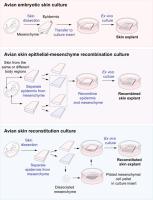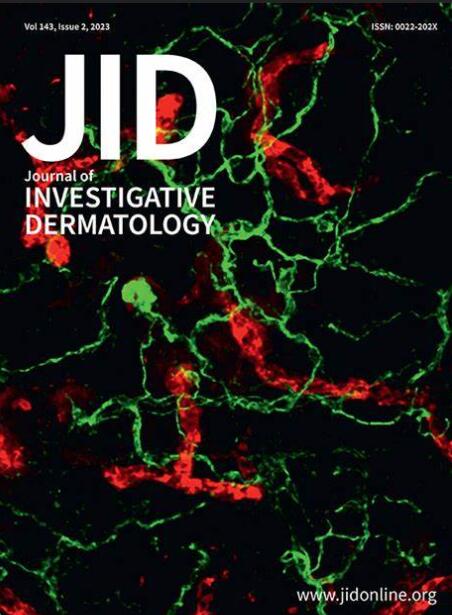胚胎禽皮肤外植体培养:研究组织模式机制的通用模型。
IF 5.7
2区 医学
Q1 DERMATOLOGY
引用次数: 0
摘要
鸟类皮肤外植体培养为研究胚胎发育过程中组织模式的基本原理提供了一个强大的平台。这种离体系统保留了发育中的皮肤的固有特性,同时实现了精确的操作和实时成像,以探索生物化学和生物物理线索如何引导跨越空间和时间的模式形成。在这篇综述中,我们重点介绍了胚胎外植体培养的三种主要形式,并讨论了每种形式如何有助于我们理解毛囊形成过程中的形态发生过程,如羽毛芽的起始、间距、取向、伸长和内陷。首先,皮肤外植体培养可以直接可视化羽毛芽或鳞片的形成,并通过全局或局部分子处理促进功能分析。其次,上皮-间充质重组通过重组表皮和间充质剖析组织相互作用,揭示诱导间充质信号和表皮能力如何定义皮肤附属物的身份和取向。它可以通过异位或异时重组进一步探索。第三,皮肤重建通过将分离的间充质细胞与完整的上皮细胞结合来重置发育程序,从而允许研究自组织和周期性模式启动的潜在规则。总的来说,鸟类皮肤外植体培养作为一个通用的、可访问的平台,用于揭示分子、机械和生物电线索如何整合以协调复杂的组织模式。本文章由计算机程序翻译,如有差异,请以英文原文为准。

Embryonic Avian Skin Explant Cultures: A Versatile Model for Investigating Tissue Patterning Mechanisms
Avian skin explant cultures provide a powerful platform for studying the fundamental principles of tissue patterning during embryonic development. This ex vivo system retains the native properties of developing skin while enabling precise manipulation and live imaging to probe how biochemical and biophysical cues guide pattern formation across space and time. In this review, we highlight 3 major forms of embryonic explant culture and discuss how each has contributed to our understanding of morphogenetic processes such as feather bud initiation, spacing, orientation, elongation, and invagination during follicle formation. First, skin explant culture enables direct visualization of feather bud or scale formation and facilitate functional analysis through global or localized molecular treatments. Second, epithelial–mesenchymal recombination dissects tissue interactions by recombining epidermis and mesenchyme, revealing how inductive mesenchymal signals and epidermal competency define skin appendage identity and orientation. It can be further explored through heterotopic or heterochronic recombination. Third, skin reconstitution resets developmental programs by combining dissociated mesenchymal cells with intact epithelium, allowing the study of self-organization and the underlying rules governing periodic pattern initiation. Collectively, avian skin explant cultures serve as a versatile and accessible platform for uncovering how molecular, mechanical, and bioelectrical cues integrate to orchestrate complex tissue patterning.
求助全文
通过发布文献求助,成功后即可免费获取论文全文。
去求助
来源期刊
CiteScore
8.70
自引率
4.60%
发文量
1610
审稿时长
2 months
期刊介绍:
Journal of Investigative Dermatology (JID) publishes reports describing original research on all aspects of cutaneous biology and skin disease. Topics include biochemistry, biophysics, carcinogenesis, cell regulation, clinical research, development, embryology, epidemiology and other population-based research, extracellular matrix, genetics, immunology, melanocyte biology, microbiology, molecular and cell biology, pathology, percutaneous absorption, pharmacology, photobiology, physiology, skin structure, and wound healing

 求助内容:
求助内容: 应助结果提醒方式:
应助结果提醒方式:


